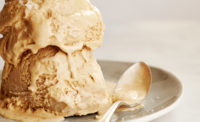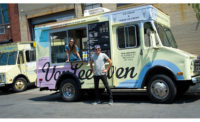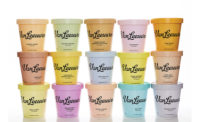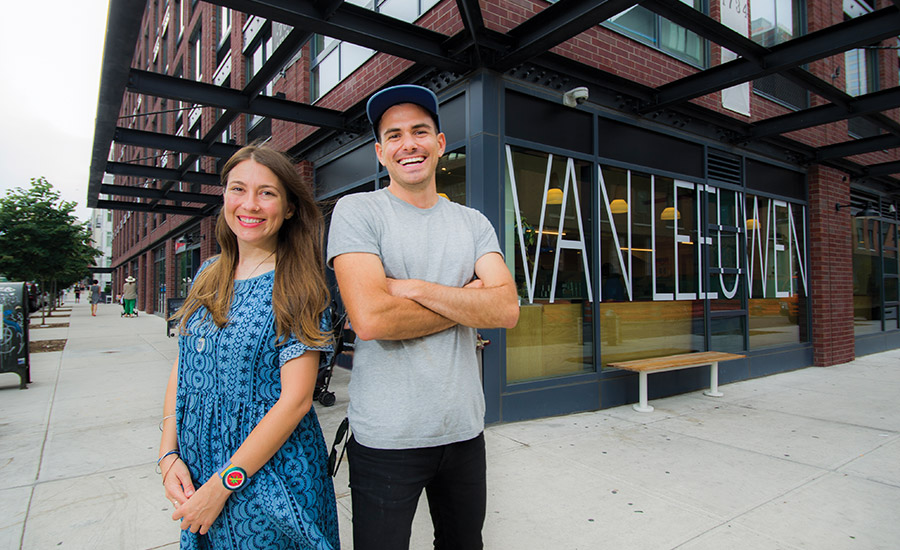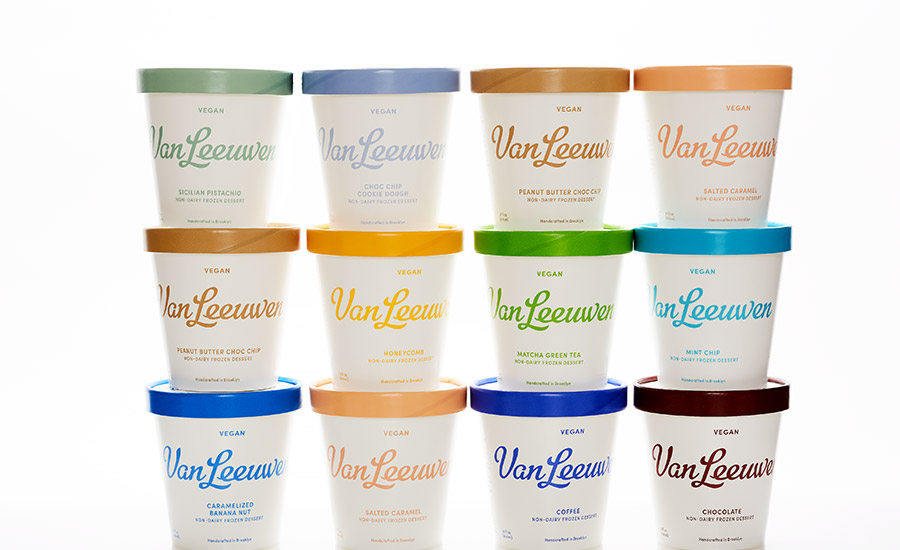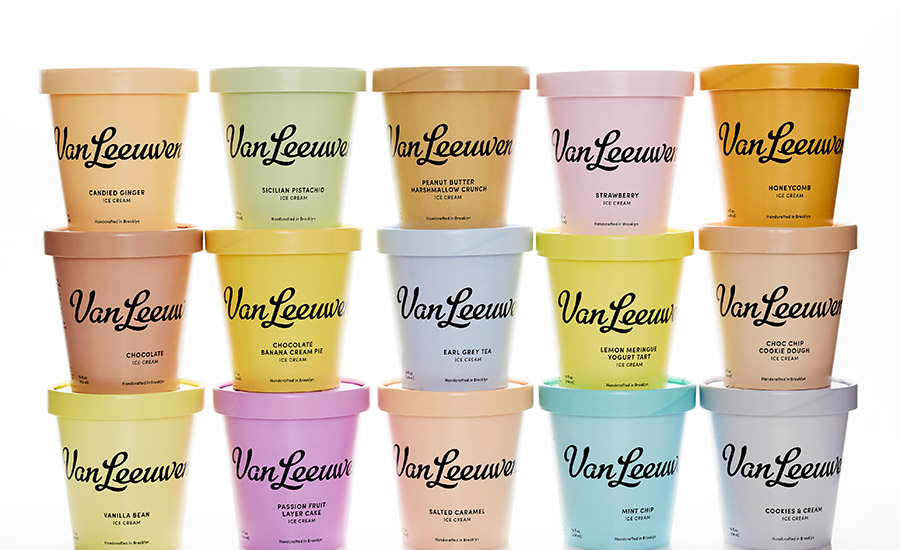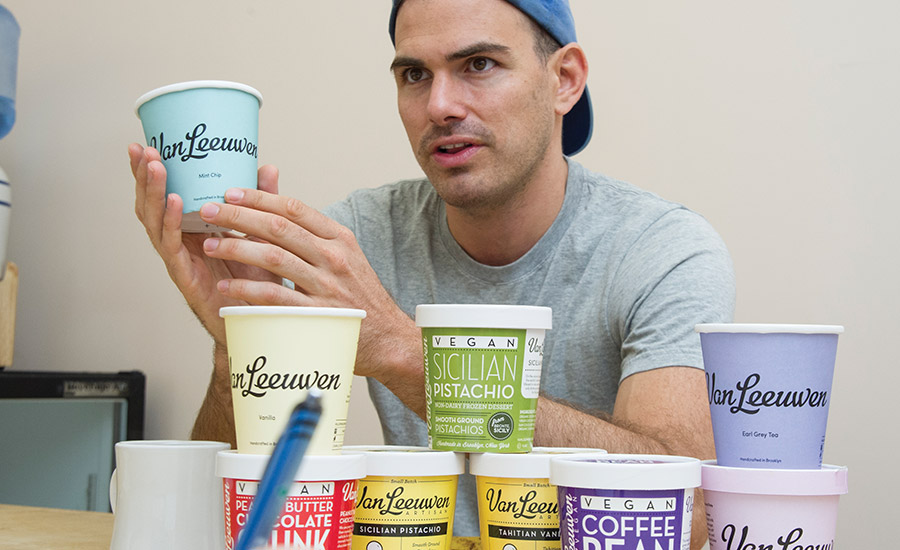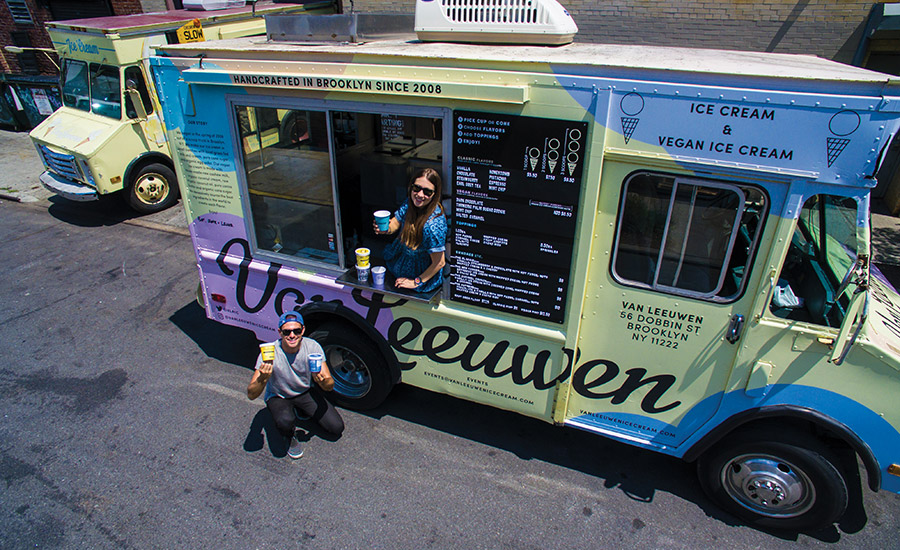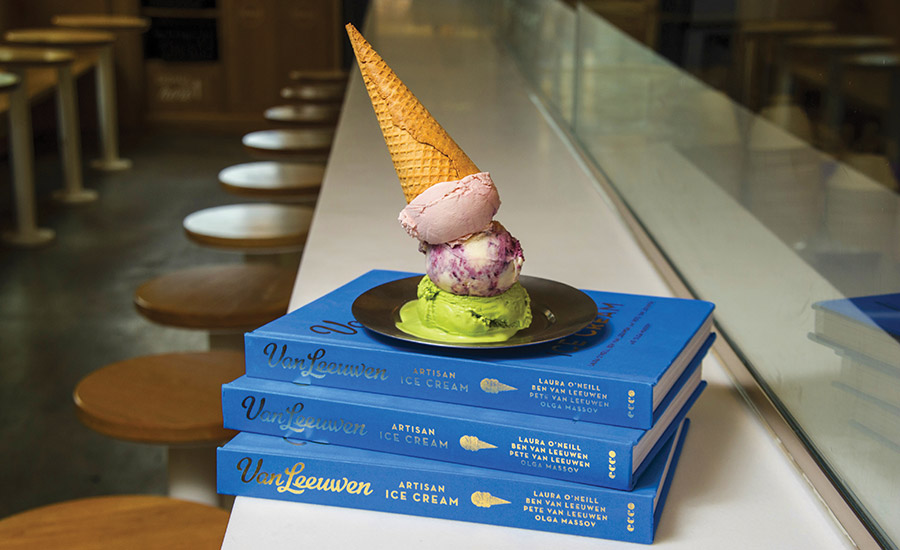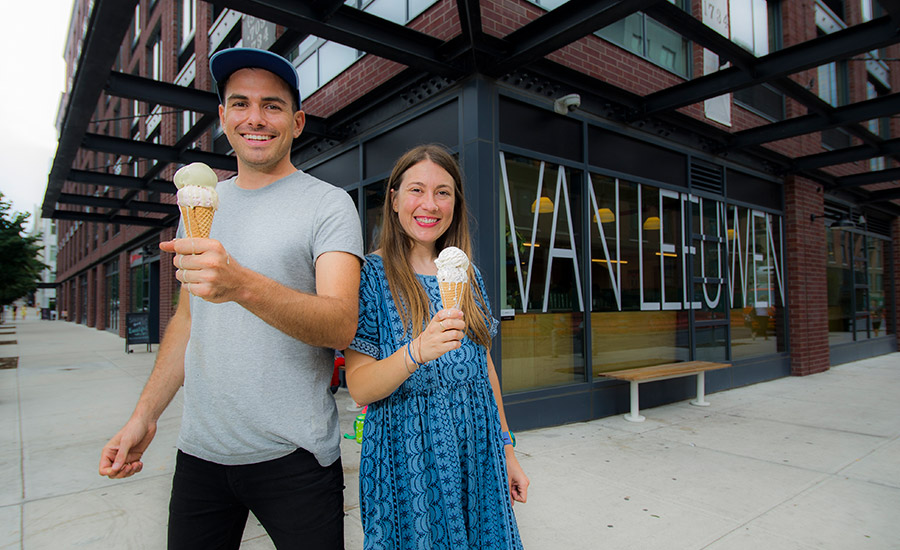Van Leeuwen Artisan Ice Cream aims for authenticity, quality
The Brooklyn-based ice cream maker has found success building its own mini-empire of stores and trucks. It can boast of steady growth while staying true to its dedication to quality.

Van Leeuwen Artisan Ice Cream co-founders Ben Van Leeuwen (right) and Laura O’Neill stand outside their Williamsburg shop in Brooklyn. The company’s goal is to appeal to people of all ages and backgrounds with its dairy and vegan ice cream.

The company recently updated the packaging on its retail line to be more reflective of the brand’s message. The new design is more cohesive and clean, with the dairy line in colored cups and vegan line in white cups. It also added 10 new flavors to the line.

The company recently updated the packaging on its retail line to be more reflective of the brand’s message. The new design is more cohesive and clean, with the dairy line in colored cups and vegan line in white cups. It also added 10 new flavors to the line.

Co-founder Ben Van Leeuwen, shown here with the company’s old and new retail packaging, discusses the company’s focus on ingredients and authenticity.

O’Neill calls the ice cream trucks “amazing moving billboards.” The company is in the process of redesigning all of its trucks to the design shown here. The remodeled 1980s trucks have seen a couple different looks over the years.

Laura O’Neill said they wanted the company’s cookbook, which was released last summer, to look and feel “timeless,” not just like company merchandise. They wanted the book to be an ultimate “reference guide for making ice cream.”


























Van Leeuwen Artisan Ice Cream wants to make people happy with ice cream. The company set out to revive the classic American ice cream truck and the art of traditional ice cream making using only the highest-quality ingredients and no stabilizers. For the company, it’s about being authentic and making ice cream that is truly pure.
Run by co-founders and brothers Ben and Peter Van Leeuwen, along with co-founder Laura O’Neill, the company has become what it describes as a “mini ice cream empire.” Appealing to a broad audience, it makes both dairy-based and vegan ice cream from just a handful of fresh and specially sourced ingredients.
At $5.50 ($6 for vegan) for a single scoop, the ice cream is definitely not cheap. But the company insists once people taste the ice cream, they almost always come back, whether once a month to indulge or as dedicated repeat customers.
The business got started on the streets of New York City with one refurbished ice cream truck and a dream. Today, the company has four trucks and five shops in New York, and two trucks and three shops in Los Angeles. It also sells 14-ounce packages in Whole Foods across New Jersey, Connecticut and New York, and other local stores, like Dean and DeLuca and Gourmet Garage. The ice cream retails for $7.69 and the vegan product for $10.99.
To keep up with growing demand, the company moved in January into a new 5,000-square-foot plant in Greenpoint, an up-and-coming neighborhood in Brooklyn. Prior to its move, the company produced all of its ice cream out of an 800-square-foot kitchen in a nearby Greenpoint location.
Crafting the perfect ice cream
The company’s goal is to give every customer the greatest value in the entire ice cream business by making “the absolute most delicious ice cream possible,” said Ben Van Leeuwen. That is certainly a lofty goal considering the competition, but Van Leeuwen really believes in what he is making.
The company describes its ice creams as a “rich, decadent, naturally perfect ice cream.” It aims to appeal to customers of all ages, ethnicities and backgrounds. Anyone who likes good ice cream and wants to “be happy,” is our customer, said O’Neill.
The company makes what it calls “classic” ice cream (dairy-based) and vegan ice cream. The custard-like classic versions have a high egg yolk content and are high in butterfat.
When asked what artisan means to him, Van Leeuwen said, “Our entire focus is [about] the quality rather than efficiency in the business.”
He explained further. “We figure out how to make the most delicious flavor possible — whether it’s really traditional processes, amazing artisanal ingredients — and then we figure out how much it will cost. We never look at cost first ever. That’s our commitment to artisanship.”
This method of running a business means it’s not really all about the money for them. According to Van Leeuwen, the owners haven’t amassed a lot of personal wealth in this business. Much of what they make, they put back into the company.
“We’re making less than [other companies] because we’re putting so much money into ingredients and processes, because if we weren’t doing that, there’d be no point,” he said. “We may as well become investment bankers if it was just about money.”
Making a product that they are proud of is what matters most to the entire team at Van Leeuwen.
“We don’t ever waver on the quality of ingredients. So when we say we’re using the best chocolate, that’s the only chocolate we’re using,” said Van Leeuwen.
O’Neill added, “We’re so curious about where [ingredients] are coming from or what makes them special and learning about who is making them or growing them.”
It’s the farm-to-fork mentality at its finest. Or farm to scoop, in their case.
With so many artisan ice cream companies popping up, even in New York alone, I asked the ice cream makers if they were worried that artisan could just be a fad.
Van Leeuwen doesn’t see it as a fad at all. “Artisan ice cream is just a really awesome, super-traditional, best version of ice cream,” he said.
O’Neill chimed in, “It’s also not a new thing. It’s going back to the life of homemade before [it became] so heavily industrialized. I don’t think people wanting real food is [going] to be something that goes away.”
Authenticity in flavors
Just as ingredients are important, so are the flavors the company chooses to offer.
O’Neill and Van Leeuwen both said they listen to the customers when coming up with new flavors. The goal is to make the flavors special in some way, whether that’s with a unique concept or with certain ingredients.
As for what else inspires new flavors? Van Leeuwen said he usually gets the ideas on a whim.
“I’ll just be sitting, meditating, and that’s it… I don’t even think about flavors, but the flavor idea just pops into my head because all I think about is ice cream,” he said.
Having the new plant and more space to work with, including more storage space, has opened up many opportunities for flavor exploration and availability.
“Now that we have the new factory, we can do so many more exciting specials,” said O’Neill. “We’re able to keep [flavors] available for longer so people have more of an opportunity to try it.”
The company focuses on unique ingredients in its monthly specials whenever possible, but the goal isn’t to shock or do anything too weird, just to be different, said Van Leeuwen. Sometimes specials will involve a theme or have to do with the season, said O’Neill. For example, when Dairy Foods visited in July, some of the summer specials included s’mores; pine ice cream with cornbread and a red current swirl; and malt with marionberry birthday cake.
The honeycomb flavor was originally a seasonal flavor but was such a huge hit that the company made it a permanent flavor in the shops and added it to the retail line. The funny thing is this flavor doesn’t have any honey in it. It’s made with sugar and rice syrup. It is chewy on the outside and crunchy on the inside with a caramel-like taste. It’s called honeycomb because of how it looks.
Some of the most successful flavors are the peanut butter marshmallow crunch (a slightly salty peanut butter ice cream with swirls of house-made marshmallow fluff, peanut and cacao nib brittle dust), Earl Grey tea and vegan salted caramel.
The ice cream shop experience
In its shops Van Leeuwen offers 12 classic flavors, nine vegan flavors and a rotating list of four special flavors which change monthly. Some of the classic flavors include chocolate, strawberry, mint chip, honeycomb, ginger (featuring pieces of real ginger) and Sicilian pistachio. Vegan options include salted caramel, dark chocolate, banana nut and matcha green tea.
The retail line is made up of 16 classic flavors, including chocolate, Sicilian pistachio, strawberry, cookies and cream, salted caramel and peanut butter marshmallow crunch; and 10 vegan flavors, including peanut butter chocolate chip, coffee, honeycomb and mint chip. When a flavor does really well in the shops, it gets considered as an addition to the retail line.
The shops are a “great test market” to see what really works in the flavor department, said “O’Neill.
On the day Dairy Foods came to town, we visited the company’s Greenpoint and Williamsburg scoop shops. The Greenpoint ice cream and coffee shop is a very small storefront tucked away near a street corner. If you aren’t paying attention, you could very well miss it. The interior is small but inviting and has the feel of a hip coffee shop.
The corner shop in Williamsburg is larger and features an almost entirely glass front (windows and doors), lined with some red brick and black trim. It’s bright and friendly, the epitome of urban and modern. The center of the room features a long scoop area lined with stools and tables. Additional stools and booths line the shop.
Customers can order ice cream in sugar or house-made waffle cones or in stainless steel bowls with spoons of the same material. For the to-go customer, ice cream is served in compostable bagasse containers made of cane sugar fiber with spoons made from corn. Finding ways to be sustainable is important to the company.
Both shops are true to the style of what the company is going for — modern, simplistic, open and inviting to everyone, but still timeless. As O’Neill said, the goal was to make sure the ice cream shops appeal to people of all ages.
Making a name for itself
The company’s vegan ice cream helps it to stand out from its competition. Van Leeuwen said there really aren’t a lot of great vegan and nondairy ice cream options at retail. He believes his company makes the “absolute best vegan ice cream” and the care it puts into it and ingredients it uses all comes out in the flavor. He believes the same about its dairy ice cream, of course, but knows there’s a lot more competition in that area. This is why crafting amazing flavors is so important to them.
The company recently updated all of retail packaging to be more reflective of the brand and its message and to stand out in the freezer. The new design is simple and clean but more cohesive. Each dairy flavor features its own special cup color with black lettering, and all of the vegan flavors feature white cups with colored lettering.
Most of the company’s growth has been through word-of-mouth. The ice cream trucks serve as “amazing moving billboards,” said O’Neill. The company is also working with a distributor that believes in the products and helps to actively sell it, she said.
Instagram is another great marketing tool. The company currently has over 19,000 followers. The social media channel has helped the ice cream maker grow, interact with customers and showcase its flavors. The company has one person dedicated to handling all the social media.
The company is also in the process of redesigning all of its trucks. The remodeled 1980s’ trucks have seen a couple different looks over the years. The new design, though still keeping to the original pale yellow, also features a splash of light purple and blue and a large Van Leeuwen logo that spans across the bottom half of the truck.
Last summer, the company released its Van Leeuwen Artisan Ice Cream cookbook.
O’Neill said they wanted the book to be an ultimate “reference guide for making ice cream” and to tell the company’s story.
Van Leeuwen said it’s important to him for people to see the passion and authenticity behind the company’s story.
An idea is born
The company started in 2008 with a buttery yellow ice cream truck on the streets of New York City. It was the epitome of a trendy little start-up.
The inspiration came from several different factors. When Ben was in college, he spent two summers driving Good Humor ice cream trucks with Peter around the suburbs of Connecticut. After college, when he moved to New York, he was inspired by the different ice cream trucks he saw. And he had a desire to create a product that he hadn’t been able to find.
Van Leeuwen and O’Neill met in 2006 while both were in London. O’Neill, who’s originally from Melbourne, Australia, moved to New York and teamed up with Ben and his brother Peter Van Leeuwen to explore Ben’s ice cream business idea. She and Ben were married to each other but have since separated.
O’Neill said her “passion for good food aligned perfectly” with the Van Leeuwen brothers. She describes Ben as a “natural born entrepreneur,” who is a “little bit crazy, (but in a good way),” and “brilliant.” He called O’Neill the grounding force behind the company. She’s the “thinker” the one that holds things together and is a “good operator,” he said. Despite not being together anymore, the business partners are still friends and have a really good working relationship.
Getting into the ice cream business was quite a leap for the Van Leeuwen team, considering none of them had a real background in food or even running a business. O’Neill, who’s now 34, had spent of much of her early career in event producing back in Australia, and had experience in customer service and fashion retail. She also worked at an art gallery and a record label in New York.
Ben, now 32, was just out of college and working as a waiter and in hospitality. Brother Peter, now 39, is a musician who worked in art handling and had been a brand ambassador for a Norwegian vodka company.
“We just kind of all had odd jobs to pay rent, etc., while we were getting started,” said O’Neill. Jobs they had to keep for a while as they continued to build the business and find its footing.
Getting started
In 2007, O’Neill and the Van Leeuwen’s started tinkering around with recipes and making ice cream in the kitchen in their Brooklyn apartment. They tested different recipes on family and friends and homed in on the best. From there, armed with a $25,000 investment from family and friends and $50,000 loan, the company bought an ice cream truck, re-vamped it and took to the streets in June of 2008. The company bought its second truck a few months later. In just 18 months the partners opened an ice cream and coffee shop in Greenpoint.
The company was using Mercer’s Dairy in Boonville, N.Y., as a co-packer in the early days before realizing that logistically (and to keep control over the product), it made more sense to bring production in-house. It moved on from Mercer’s in 2011 and started making ice cream in Greenpoint.
The company landed the Whole Foods account in 2009, thanks to a bit of luck. On their first day in the truck, O’Neill and Ben had been selling ice cream for only a couple of hours when a representative from Whole Foods happened upon them. The rep offered them an opportunity to bring pints into local Whole Foods. Since it was so early in the business, Van Leeuwen and partners waited until they got their feet a bit more wet, hence the retail launch the following year. But the relationship with Whole Foods has been strong ever since.
The company opened its first shop in the arts district in Los Angeles last year, though it had an ice cream truck hitting the streets there in 2014. Peter Van Leeuwen moved there three years ago and heads up that end of the business. He works from one of the shops and out of a home office, and collaborates with the team back in New York.
The challenge going forward for the company is to remain competitive. Ben Van Leeuwen pointed out that when they first got started, there actually weren’t that many people making artisan ice cream. Now he admits it’s become a lot more saturated.
Looking ahead
O’Neill describes the company’s growth as steady.
“This past year has seen the most growth but it was very well thought out from our side,” she said. The company saw 30% growth from 2014 to 2015, and 60% growth from 2015 to 2016.
Van Leeuwen and O’Neill said the focus for the company going forward is growing its wholesale distribution of the 14-ounce cups. This is the path they feel will grow the company.
“We are still putting care and energy into our stores and trucks, but [we’ll] be putting our main focus on pint wholesale for now,” said O’Neill. “Our brand new packaging and flavors have hit the shelves and are doing great. We can still blow up a lot more in New York. There are a lot of stores that don’t have us yet.”
The company’s goal is to be available in stores nationally within the next few years, if not sooner.
“We’ll [also] continue to open more retail outlets in key markets, and continue to saturate New York City and Los Angeles with more stores, and we will begin diversifying our product lines,” said Van Leeuwen. He hinted at the idea of novelties, like ice cream sandwiches and ice cream on a stick, as something the company might explore.
Van Leeuwen said the company maintains its competitive edge by “having unwavering dedication to quality and constantly staying on the cutting edge of development.” And this will be its pledge going forward.
Looking for a reprint of this article?
From high-res PDFs to custom plaques, order your copy today!





